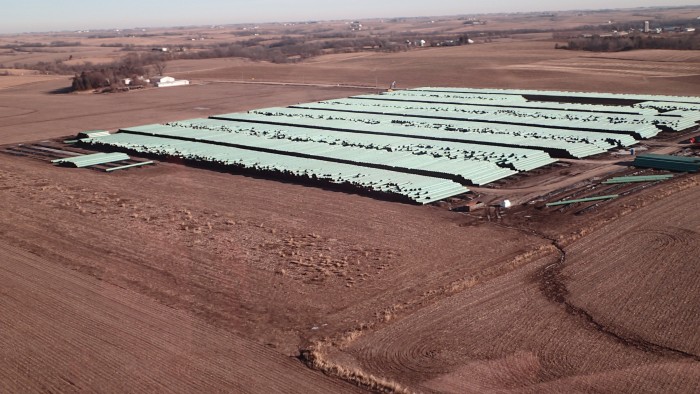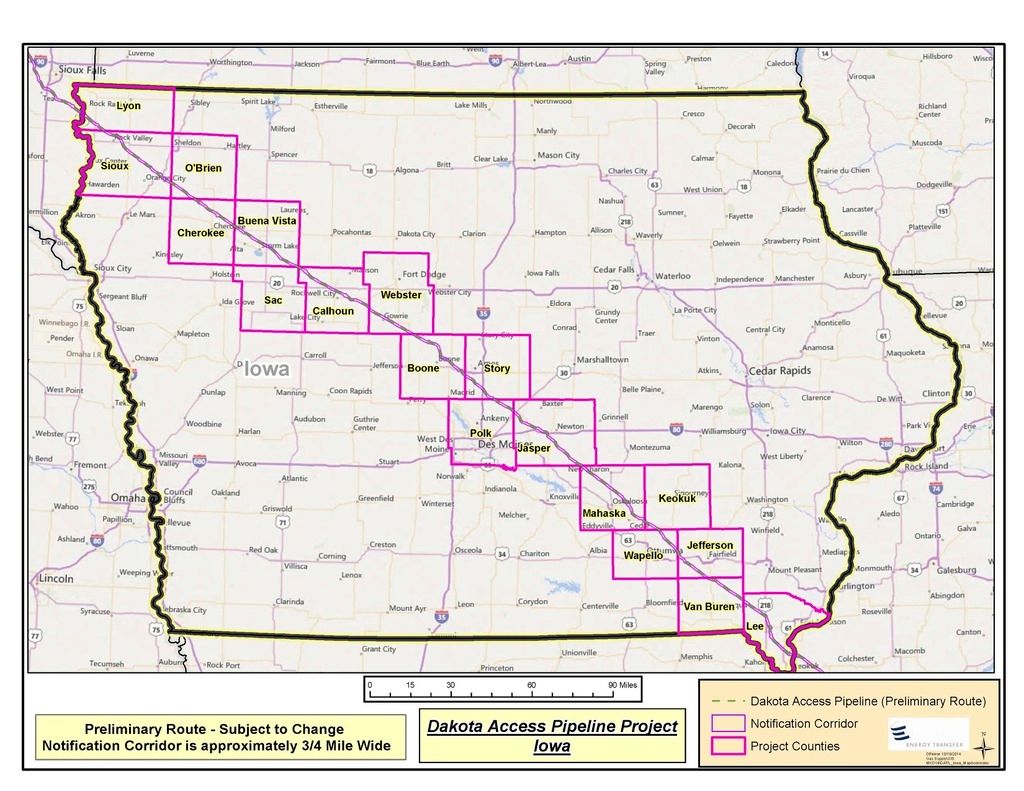The U.S. Army Corps of Engineers has granted the Texas-based Dakota Access company a federal permit to build the Bakken pipeline across Iowa.
Although opponents plan various forms of direct action, the best remaining chance for stopping the pipeline is a lawsuit challenging the Iowa Utilities Board’s authority to use eminent domain for a project with no legitimate public purpose.
The advocacy organization Iowa Citizens for Community Improvement, part of the Bakken Pipeline Resistance Coalition, announced in a news release yesterday,
The authorization of Pre-Construction Notifications (PCN’s) essentially allows the pipeline to cross 64 waterways, and clears the last official regulatory hurdle Dakota Access faces.
In a letter dated July 25, 2016 and filed with the Iowa Utilities Board (IUB) today, the US Army Corps issued conditions under which Dakota Access may move forward with construction of the 1,168 mile pipeline. The Corps’ authorization specifically addresses conditions over 60 water crossings.
The end of the Corps’ letter to Dakota Access states it wants Dakota Access to complete a questionnaire to ensure that the Corps is giving its “customers” timely and efficient service.
The Corps has rarely been seen as receptive to environmental concerns about construction projects, so I’m not surprised the oil company received the permit. That said, how sad for any federal agency to explicitly view private business as its key “customers.” The permitting process is supposed to protect the public interest.
Bakken opponents have long called for a more thorough federal review of the pipeline’s environmental impact. The Corps considered only the impact of Bakken segments that would cross tribal lands.
The Iowa Department of Natural Resources has accommodated the oil company’s requests and preferred construction timeline as well. Only weeks after issuing a stop-work order because of a “discovery of a significant archaeological site” along the pipeline route, the DNR amended a permit to allow Dakota Access to run the pipeline under a sensitive area in the Big Sioux River Wildlife Management Area. Bleeding Heartland user John Morrissey commented at the time,
This is very alarming. First, burying the pipeline 85 feet below ground means that if it ever leaks, there is NO WAY the pipeline operator will ever be able to dig it back up. It also assures that there is a direct injection of oil into the aquifers that Iowans depend upon for their water sources. In its environmental review filed with DNR, Energy Transfer Partners did not indicate that any of its several underground crossings will be equipped with shut off valves that would enable the company to isolate a deeply buried pipe segment in the event of a leak or suspected leak. It is fair to assume that such provision will not be made and that the tremendous risk posed by such leaks is borne solely by the people of Iowa.
Secondly, the horizontal boring technique means the install crews will first drill a horizontal run that is typically 1,000 feet long, or longer. That means the drilling component will generate thousands of cubic feet of drilling spoils, which ETC did not bother to describe how they will be disposed, except to hint that they will be piled on the ground and allowed, by natural processes, to find their way into nearby surface waters. And once the bore hole is complete, the crews will drag the assembled pipeline from the far end or exit of the bore hole back to the entry point. That means 1,000 feet or more of assembled pipe will be subject to all manner of abrasive scraping as the pipe is dragged through bedrock, erratic boulders or other hard, sharp objects buried underground in the bore hole path. The installation crews will have no way of knowing if or how badly scarred the protective wrap on the outside of the pipe could be damaged. And even if they did suspect or know of such damage, they could not repair it. ANY deep scratching, tearing or perforations in the outside skin of the pipeline will ultimately be fatal to it’s integrity years after it is installed.
Thirdly, the legal precedent of allowing a user to usurp tribal claims by burrowing underground fits perfectly with the view held by Texans that fee title means nothing when they wish to use lands that do not belong to them for their own purposes, but does raise troubling questions about whether the tribes really do own their land, and if they do, under what circumstances can others confiscate it for their own purposes. ETC’s use of eminent domain to grab Iowa lands from owners not willing to allow the proposed use is bad enough; to now expand the thievery to include the taking of tribal lands is a sad contribution to the generations of land theft committed against these tribes.
Finally, the DNR’s ruling is very bad public policy, as its initial sovereign lands approval was conditioned upon ETC self-reporting any archaeological, ecological, geological or hydrological field findings that might be of interest to the state or federal authorities. That itself was an abject failure to assert regulatory authority over this project. To now allow construction to proceed without so much as even a hearing on the matter confirms my worst misgivings that the DNR has not taken this matter seriously and is apparently incapable of providing any meaningful oversight for this project.
Well said.
Early phases of construction work have been underway in Iowa for several weeks. With state and federal permits in hand covering the whole pipeline route (map enclosed below), the company is portraying the project as a done deal. William Petroski reported yesterday for the Des Moines Register,
“We can now move forward with construction in all areas as quickly as possible in order to limit construction activities to one growing season and be in service by the end of this year,” Dillinger said.
Construction activities are underway on all four “spreads” of work along the route in Iowa, Dillinger said. These early stages of construction include staking, grading, clearing, temporary road construction, and building of temporary fences and gates. Areas of construction that began in early June in southeast Iowa have started stringing and welding pipe, she added.
“We have signed easement agreements on 96 percent of the properties along the route in Iowa,” Dillinger said. “We have signed 100 percent of the properties in North Dakota, South Dakota and Illinois. The plan remains to be in service by the end of this year.” […]
Much of the Iowa pipeline route will cross farmland, where the pipeline must be buried under a minimum of 48 inches of soil. Agricultural drainage tiles will be crossed with a minimum of 24 inches of separation between the pipe and the drain tile. Topsoil will be segregated during construction to a minimum of 12 inches or in accordance with landowner requirements, officials said.
Many landowners along the pipeline route refused to sign easement agreements, and some have joined lawsuits challenging the Iowa Utilities Board’s authority to use eminent domain to condemn farmland for this kind of project. Click here for background on the main legal arguments.
Bill Hanigan, a Des Moines-based attorney representing some of the plaintiffs, told Bleeding Heartland today that separate lawsuits filed in Cherokee and Calhoun counties were dismissed–not on their merits, but so the cases could be consolidated with the lawsuit filed in Polk County District Court in April. No court date has been set for that lawsuit. Hanigan confirmed that Dakota Access cannot build the pipeline over the disputed parcels while the case is pending. He could not say exactly how many parcels are affected.
Dakota Access may hope that completing as much of the pipeline as possible before landowners get their day in court will reduce the chance of a judge ruling that the Iowa Utilities Board exceeded its authority.
Any relevant comments are welcome in this thread.
Proposed Bakken pipeline route:
July 26 press release, Iowa CCI:
Army Corps issues Bakken Pipeline Permit
Iowa CCI members & Bold Iowa blast “business as usual” regulatory decision; vow ongoing resistance through non-violent direct actionDes Moines, IA. Iowa Citizens for Community Improvement (Iowa CCI) and Bold Iowa today challenged the permit authorization granted to Texas based Dakota Access by the US Army Corps of Engineers. The authorization of Pre-Construction Notifications (PCN’s) essentially allows the pipeline to cross 64 waterways, and clears the last official regulatory hurdle Dakota Access faces.
In a letter dated July 25, 2016 and filed with the Iowa Utilities Board (IUB) today, the US Army Corps issued conditions under which Dakota Access may move forward with construction of the 1,168 mile pipeline. The Corps’ authorization specifically addresses conditions over 60 water crossings.
The end of the Corps’ letter to Dakota Access states it wants Dakota Access to complete a questionnaire to ensure that the Corps is giving its “customers” timely and efficient service.
“Today’s decision from the Army Corps isn’t a surprise,” said Cherie Mortice, Iowa CCI Board President from Des Moines, IA. “It has been ‘business as usual’ for Iowa and federal regulators – putting corporate interests ahead of the common good and our land.”
Bold Iowa, Iowa CCI and other groups in the Bakken Pipeline Resistance Coalition remain steadfast in their opposition to the pipeline for environmental, social, and moral reasons.
“The proposed Bakken Pipeline is all risk and no reward for Iowa,” said Dick Lamb, a Boone Co. landowner in the pipeline’s path. “It isn’t a question of if but when it will leak, and when it does it will irreparably destroy valuable Iowa farmland and the waterways we depend on.”
Pipeline fighters vow to continue building resistance. Direct actions, rallies, and events are ongoing to mobilize more Iowans who are opposed to the pipeline.
“I’m disappointed in the Corps but even more disappointed in President Obama, who has the power to stop this pipeline yet has done nothing,” said Bold Iowa director Ed Fallon. “When the President sees hundreds of us getting arrested, standing side-by-side with our landowner and tribal allies as we block construction of the pipeline, then maybe he’ll do something.”
· Lakota/Dakota Tribal Youth from near the North Dakota Bakken oilfields stopped in Des Moines Saturday for a rally with Bold Iowa, en route on a cross country marathon run to Washington DC;
· A lawsuit filed by ten landowners alleging that Dakota Access cannot legally be given the authority to use eminent domain remains a live round;
· Pipeline Construction monitors are being trained by the Bakken Pipeline Resistance Coalition to observe and report potential environmental violations and/or hazards;
· And Iowa CCI and Bold Iowa continue to build a team of hundreds of everyday Iowans who are committed to engaging in non-violent civil disobedience to delay and halt construction. The Pledge of Resistance can be found here.“We remain steadfast that oil will not follow through this pipeline.” concluded Adam Mason, State Policy Director at Iowa CCI. “We’ll continue to fight tooth and nail – this is not a done deal.”
“We need to leave this oil in the ground and turn the corner to true renewable energies like wind and solar that will create good jobs, protect our environment, and build our communities.” added Mason.
Iowa CCI is part of a growing number of organizations, landowners, and everyday citizens across the state committed to stopping the proposed Bakken Pipeline alongside the Bakken Pipeline Resistance Coalition. Visit www.nobakken.com.
Bold Iowa is part of the national Bold Alliance, now in five states and building new alliances to fight fossil-fuel infrastructure expansion projects and promote renewable energy. Visit www.boldnebraska.org/tag/bold-alliance.
Iowa CCI is a statewide, grassroots people’s action group that uses community organizing to win public policy that puts communities before corporations and people before profits, politics, and polluters. CCI has been fighting to put people first for 40 years. Visit www.iowacci.org.
Top image: pipes intended for use in the Dakota Access pipeline being stored in Jasper County, Iowa during 2015. Photo provided by Wallace Taylor, used with permission.


